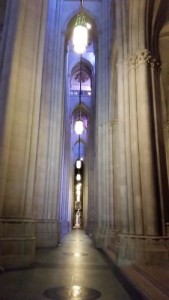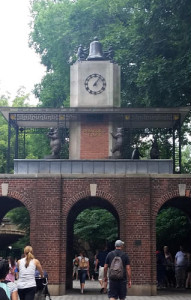I thought I wasn’t going to be able to finish this issue prior to the scheduled posting date of September 8. But I did. Whew!
Quicksilver, by Kenneth Brower, photographs by Brian Skerry
Quicksilver is a picture of overfishing, which seems to be a common theme in National Geographic in recent years, told through the population of bluefin tuna. Bluefin tuna live in all of the world’s oceans except, traditionally, for the Arctic Ocean (this has apparently changed in the months since this issue went to press).
Along the way, we see how important bluefin tuna are to Japanese culture. The first bluefin tuna of the season is subject to a bidding war that raises the price far above what a bluefin normally would cost. In 2013, the first bluefin tuna went for $1.76 million. We also watch scientists who are studying bluefin tuna using tracking devices to watch the movements of the fish. Scientists used to think that different populations of bluefin stayed to their own oceans, but the use of tracking devices has put an end to that idea.
Hopefully with proper studying and fishery management, the population of bluefin tuna will rebound and reach numbers that will ensure that people will be able to eat bluefin tuna long into the future.
Star Eater, by Mark Finkel, photographs by Mark A. Garlick
Star Eater starts off on the cheerful note of the expected extinction of Earth’s sun. This made me nervous. Contemplating the death of the universe is a nice thought experiment, I guess, but it’s not really something that makes me comfortable.
Things become a lot less personal in the second paragraph, though. This is when we start to talk about the forces that cause the creation of a black hole.
The rest of the article is about the way that black holes function, only now I’m more confused than ever. In one paragraph, Finkel tells us that black holes “roam the galactic suburbs” and, later, that some are “star-shredding, planet-devouring Godzillas,” but then later, he says “A black hole has no more vacuuming power than a regular star.” I am now thoroughly confused. So there are stars that wander the galaxy and the star-shredding Godzilla would have done it anyhow even if it hadn’t been turned into a black hole?
Then we talk about the relationship between the black hole and time. Finkel tells us that if you were to fall into a black hole, time is so elongated there that we would never see you fall in. You would just be stuck there on the edge of the black hole, from our perspective, “for an infinite amount of time.” But earlier Finkel told us that at the time this magazine went to press, a gas cloud was headed towards the black hole and that we would see a ring of debris form around the edge of the black hole as it eats the cloud. Why will we see the debris of the gas cloud form, but the person on the edge of the black hole would never fall in?
I actually very, very briefly considered studying astronomy at one point, and I’m glad that the consideration was very, very brief, because I’m clearly not smart enough for this.
People of the Horse, by David Quammen, photographs by Erika Larsen
The horse evolved in what is now North America. During the era of the Bering land bridge, some horses moved to Eurasia and then an extinction event happened in North America (perhaps they were hunted to extinction), leaving North America horseless. Horses were domesticated in Eurasia, and then thousands of years later, Christopher Columbus and future colonizers brought horses back to North America, where horses settled in as though they were at home, largely because they were. Many nations of Native Americans embraced them and made them part of their culture. And they are still a major part of Native American culture today.
Quammen gives us a little of the history of the horse, but People of the Horse is largely about the relationship between modern Native Americans and their horses. We meet Toni Minthorn, whose family didn’t have enough money to provide their children with toys. The family had 47 horses, however, which saved Toni’s self-esteem.
People of the Horse goes into the events of the Native American rodeo in great detail. I won’t even try to summarize, because I couldn’t do justice to it without quoting Quammen in detail. However, if you need information on the Native American rodeo and the Indian Relay, this article is definitely a good resource.
Call of the Bloom, by Susan McGrath, photographs by Merlin D. Tuttle
I love bats. Sometimes living in Texas gets me down (particularly when the temperature is over 100 degrees Fahrenheit), but the abundance of bats is definitely a plus. Just yesterday (as I write this; it will post about six days later), Alex and I were in Fort Worth, and we saw the wings of several bats in the parking garage. So, yeah. Bats.
There are numerous species of night-blooming flower and if you think about it, with nothing to pollinate them, the flowers would have died out. Sometimes the pollinator is a moth or the rare nocturnal variety of bee, but quite often the pollinator is a bat.
Call of the Bloom goes into the mechanics of how nectar-drinking bats find the flowers that produce the nectar, including having dish-shaped leaves that bounce the sound of the bat’s cry back at them strongly. We also see how those flowers have evolved to make it easy for the bat to get the nectar out While the bat is drinking the nectar, the stamen will drop pollen onto the bat, and the pollen sticks in the bat’s fur, where it remains until it falls off into the next flower. Interestingly, while many night-blooming flowers have smells that are pleasant to the human nose, the flowers that attract bats don’t necessarily smell so good to us. McGrath describes the smell as being like cabbage, sour milk, and skunk, among other smells.
The Mexican free-tailed bat is the bat that summers here in San Antonio, and they are known to drink some nectar. The night-blooming cereus, which does have a pleasant smell to the human nose, is one of the plants that bats pollinate.. I am tempted to get one for my front yard (so that the bats don’t get into conflict with my dog) and see if I can attract some bats next summer.


